For the 2026 season, the Capita Mercury is celebrating its 10th birthday since it was first introduced to the Capita lineup. The Mercury is a directional twin, all-mountain freeride board with a hybrid-camber dominant profile that was designed to rip groomed terrain and ice and float in powder in the backcountry.
Capita Mercury 2026
Overview
Board Reviewed: 155 Capita Mercury 2026
Price of Board: $679.95
How the Price Compares to Others:
The Capita Mercury costs $167.95 more than the average snowboard price of $512.0.
Our Rating Score: 4.49 out of 5
How the Capita Mercury Ranks Against Others:
The Capita Mercury ranks 8th out of the 34 boards we reviewed in the all mountain category.
The Capita Mercury ranks 11th out of the 26 boards we reviewed in the all mountain / freestyle category.
The Capita Mercury ranks 9th out of the 30 boards we reviewed in the park category.
Who Should Buy This Board?
The Capita Mercury is perfect for intermediate to advanced riders who want one board that excels at riding the entire resort, with specific tech features built into its design to help them do it. This board is for the rider who loves to carve at all speeds and needs a board that is as strong on ice as it is in powder.
Which Type of Rider Will Get the Most Value From This Board?
The Mercury is best suited for aggressive all-mountain resort riders who prioritize speed and carving performance.
Who Shouldn’t Buy This Board?
A beginner or someone just learning to connect their turns should not buy this board. Otherwise, most of you reading this will have an excellent time on the Capita Mercury because it’s so strong in most styles of riding.
How Much Does It Cost?
The 2026 Capita Mercury costs $679.95 here and isn’t expected to go on sale until after april. You can occasionally find one from last season on sale between $399.95 – $475.96. I found a few 2025 clearance deals sizes on Amazon here.
(And if you find one cheaper, scoop it up.)
How Is the Capita Mercury In the Park?
It’s outstanding in the park, but that’s not what it is typically rated for.
The Capita Mercury is rated as being versatile enough to take anywhere at your local resort. Still, you’ll notice that in Capita’s Terrain Type Hexagon recommendations, they rate it highest for versatility and lowest for jibbing.
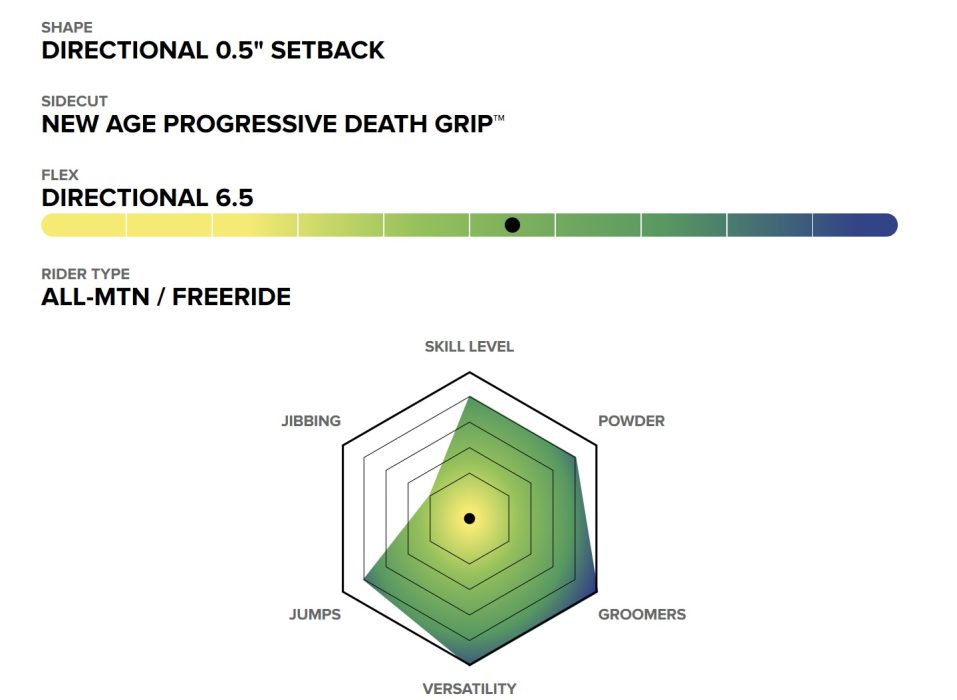
The truth is that the Capita Mercury is such a fun board, and it is so versatile that it can also be a beast of a park board.
I got to test the Mercury’s jibbing capabilities at Big Snow in East Rutherford, NJ, on September 20th, 2025, and I was very surprised by how well the Mercury could lock into a press. The Mercury’s stance is set back by half an inch, and its slightly longer nose, pressed into features with ease. The board’s stable yet powerfully snappy feel brought with it some added confidence to push myself harder to go a little bigger off jumps, too.
The Mercury is an all-mountain board that is lightweight and maneuverable when you want it to be, while controlled, stable, and responsive when you need it to be. The strengths that help it carve with such precision are the same strengths that help it dominate all aspects of riding the park.
Pros of the Capita Mercury
- It’s versatility. This is one snowboard that really can do it all.
- It locks into nose presses easily without being an overly flexible noodle.
- It’s got pop for launching you off jumps.
- It carves with total response and precision.
Cons of the Capita Mercury
- Some riders will find it to be too stiff (It’s mainly just stiff between your feet, the tips pressed nicely).
- It is on the expensive side, at $675.95 (and it’s very much still worth it as it can potentially act as multiple boards in your quiver).
My Rating of the Capita Mercury 2025 – 2026
| Considerations | Rating Out 5 | Score Out of 100 | Weight / Importance to Score |
|---|---|---|---|
| Resort Riding / Versatility | 5 | 100 | 10 |
| Pop / Power | 4.5 | 90 | 10 |
| Powder | 4 | 80 | 3 |
| Carving / Turns | 4.75 | 95 | 10 |
| Responsiveness | 4.25 | 85 | 10 |
| Speed | 4.25 | 85 | 10 |
| Ice / Poor Conditions | 4.25 | 85 | 10 |
| Switch | 4.25 | 85 | 5 |
| Jibs | 4.25 | 85 | 5 |
| Jumps | 4.75 | 95 | 10 |
| Dampness | 4.25 | 85 | 5 |
| Buttering | 4.25 | 85 | 5 |
| Fun to ride | 5 | 100 | 7 |
| Weighted Score | 4.495 | 89.9 | 100 |
The Capita Mercury held up exceptionally well with all types of riding and earned an overall rating score of an 89.9 out of a possible 100 points in our all mountain board category. This is a score of a 4.495 out of 5 stars.

Learn About How I Scored This Board
I believe a snowboard review should include more than just my opinion about my favorite aspects of the board. That’s why I put every board that I review through a consistent on-snow testing process to get real, measurable and consistent data about its performance for the type of board it is.
For the Mercury, I’m using my All-Mountain scoring system, which prioritizes a blend of carving, versatility across the entire resort, and park performance. The ‘Weight’ column below shows you exactly how much each characteristic contributes to the final score.
Sizes Available
The Capita Mercury is available in the following sizes:
147, 150, 153, 155, 156 Wide, 157, 158 Wide, 159, 160 Wide, 161, 162 Wide
See the full specs to find the size that would fit you best.
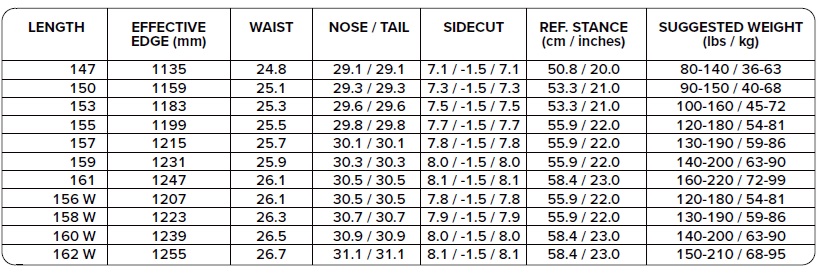
What Size Did I Ride?
I rode the 155, which felt like the right size for me. I am 142 lbs, 5’6″ tall, and wear a men’s size 9 boot.
The Resort V2 Profile: Traditional Camber With Rocker Nose and Tail
The Mercury features Capita’s Resort V2 directional profile, which combines camber between your feet with rocker in the tips to help it float and feel more forgiving.
If you were to look at the V2 resort profile from the side, it would look like this.
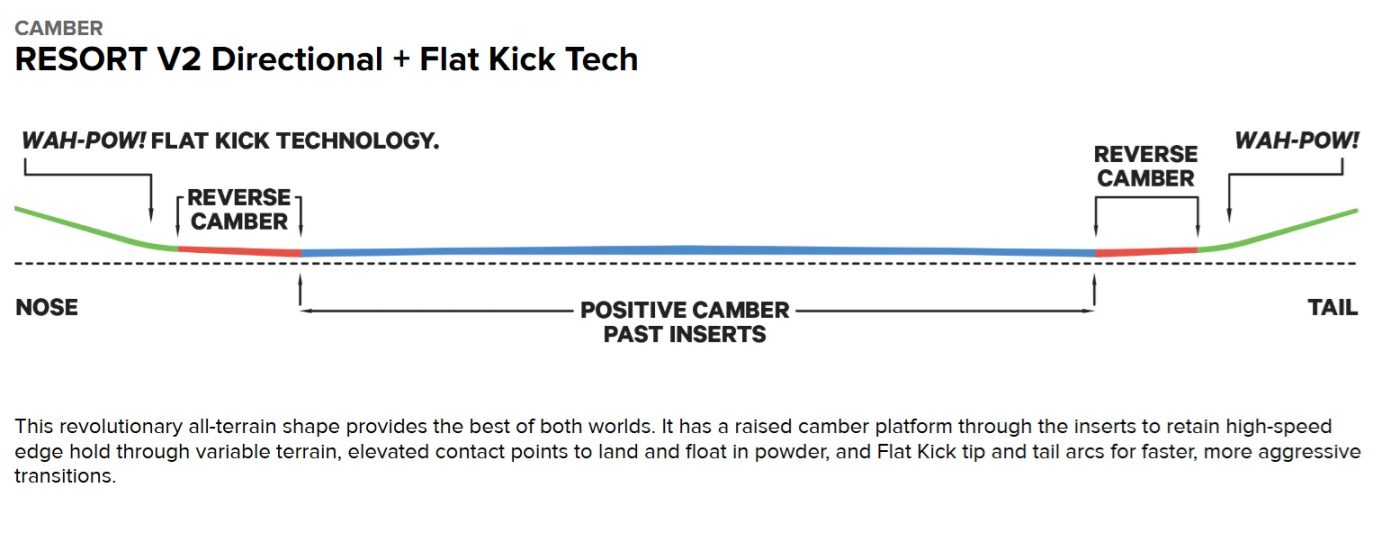
Overall, this feels like a slightly more forgiving traditional camber deck. It’s got the edge hold you’ll need for carving, and it feels noticeably more forgiving (easier) to land jumps if you’re slightly off axis.
Actual Feel of the Flex Rating
The Capita Mercury has a flex rating of medium-stiff (6.5/10). To me it felt like the nose was a little softer at a 5/10 flex, the tail was slightly stiffer at a 5.5/10 flex and the torsional flex under foot was a 5/10.
The only real place in the board that felt stiff was between the bindings longitudinally from nose to tail. I’d say that’s where this board felt like it was a 6.5/10 flex. Otherwise, it is a very approachable medium flex.
How the Capita Mercury Performs Across Different Riding Style Categories
All-Mountain / Riding the Entire Resort
Riding the entire resort felt exactly what the Mercury is built for. From the moment I stood on it, it just felt intuitive to ride and ready for whatever rutted out spots I seemed to run into.
It’s such a versatile resort board that it is ready for any type of condition the resort throws at you, whether that’s ice, groomed terrain, powder, or slush. I’d say this is the board you’ll take with you when you’re not sure what the terrain will be like. Bring this one, and you’ll have the right board for the day.
Jumping
The Mercury is right at home in the air. It’s perfect for small to large jumps and side hits. It felt like it had above average level of pop, it was damp enough to soften my landings, and the rocker in the nose and tail felt like it made landing spins a little easier.

Tech That Give the Mercury Its Pop & Power
When you look at the tech, you can start to understand why. Capita gave the Mercury their energetic Hover Core, which is made of a combo of paulownia and poplar wood for durability. The combination of multiple types of wood keeps the overall weight down and adds a boost of pop. To take things up a few notches, Capita also added in their Carbonflax™ V-Tech Amplifiers, a fusion tape fabric that combines carbon fiber with flax fibers. This technology gives the Mercury an additional boost of pop and power thanks to the carbon, while the flax adds a level of dampening to smooth out the ride.
Jibbing
I disagree with the statements you’ll read online saying that “The Capita Mercury is not ideal for jibbing due to its stiff flex profile.” It actually is a really great jibber. Especially if you like to nose press. I just wouldn’t say if you are primarily a jibber, you should get this board soley for that purpose. You get this board because you need a board that does a bit of everything.
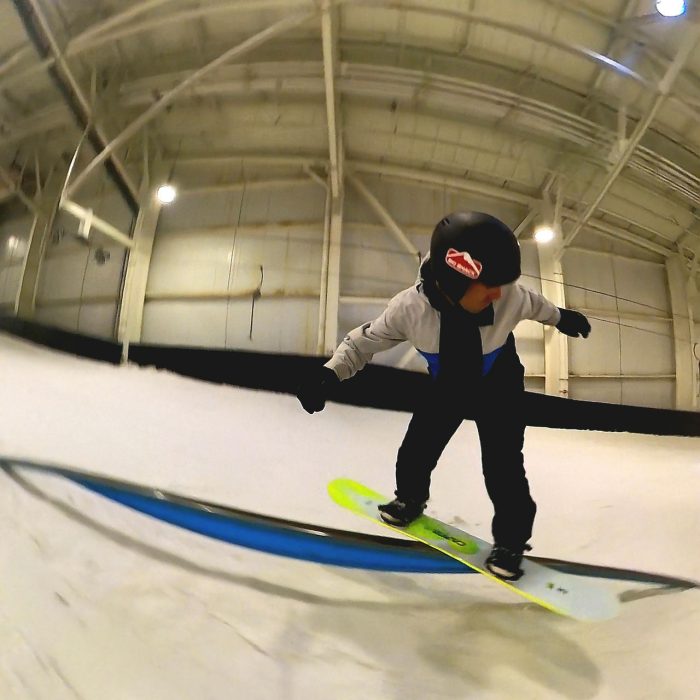
As I mentioned in the intro, I mainly wrote this review to test Mercury’s jibbing abilities, and I was pleasantly surprised. The Mercury’s long nose locks into a press, and it doesn’t feel like it’s stiffness prevented me from doing that. If anything the rockered nose with the setback stance, just made it feel easier to nose press.
So if you’re looking for an all-mountain directional board that can jib without being an overly flexible noodle, the Mercury is a solid option.
The center of the board felt a bit stiff, but it still worked well to help mold around features for boardslides and tailslides. I never felt like the Mercury’s carving features got in the way of me trying to jib, and that’s what we were aiming for with this test.
Buttering
The Mercury can butter very well, too.
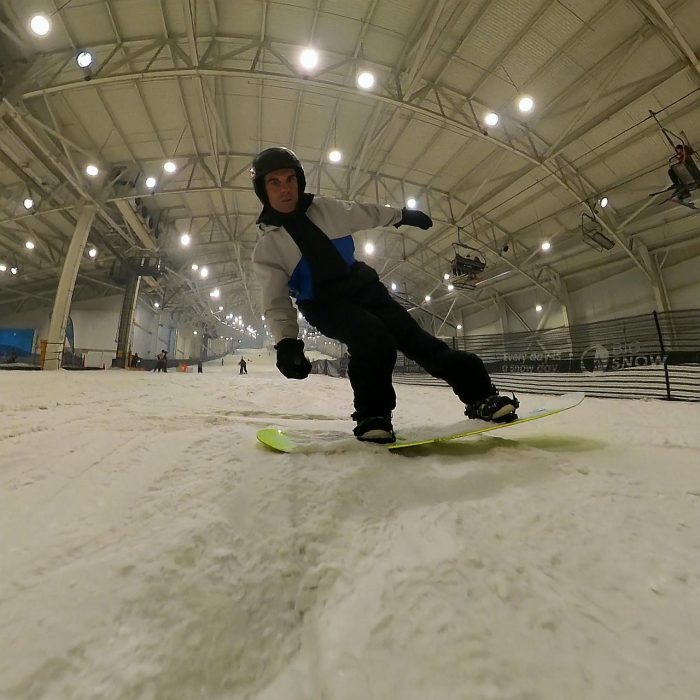
The rocker in the tips with the Flat Kick Tech makes for a very easy all-mountain board to butter with. This isn’t to say you just need to lift your foot and it’ll butter; you’ll need to put in some effort and practice. However, the rocker nose and tail pair well with the level of torsional flex to make this medium-flexing all-mountain board capable of buttering well.
With this board having Carbonflax™ V-Tech Amplifiers, you also get a nice boost of pop as it rebounds back into its original shape. That boost of pop is enough to get an extra 180 around on your flatground tricks.
Powder
I did not get to test this board in Powder, so in my rating scale, I brought the powder category’s weighting down to a 3/10. I am rating the powder category merely on the tech itself.
The Capita Mercury will float very well for you in powder because of its hybrid profile and its setback stance. The Mercury’s rocker profile in the nose and tail acts like the bow of a boat by lifting the nose of your board to prevent it from sinking. Additionally, the 0.5-inch (1.27cm) setback stance shifts your weight towards the tail slightly, which naturally raises the nose board to point upward, allowing you to glide on top of the deep snow.
How It Carves
The Mercury feels like a controlled, masterful carver of a board.
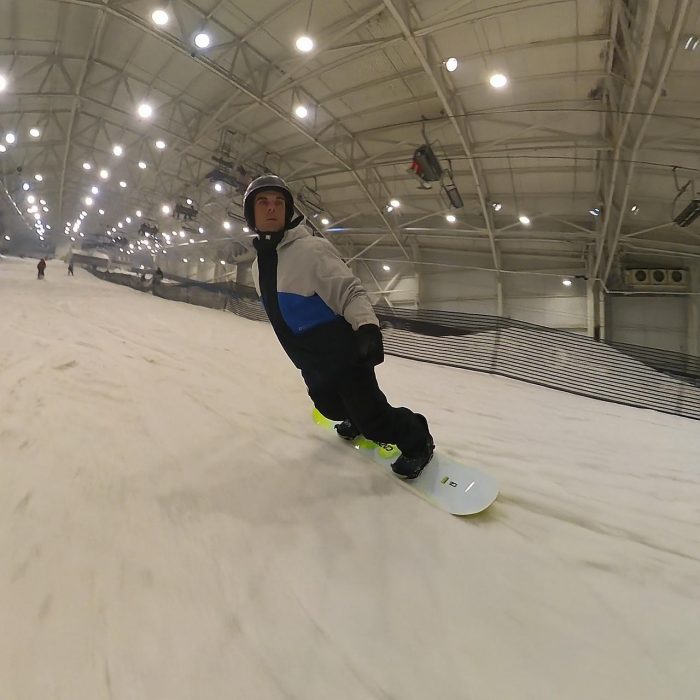
This board’s ability to carve is seriously impressive and one of the main reasons you should consider getting it. The Capita Mercury features a single disrupted serration in the center of its sidecut that acts like an additional contact point. Capita calls this serration its Death Grip tech, and it’s what gives this board an insanely strong grip (even on ice).
The turn initiation felt very quick, and once you’re on edge, the board felt completely locked in. The pop coming out of my turns felt like it added an extra boost of power, almost like it was launching me into my next turn.
Size of Carves This is Best For
The Mercury was definitely at its best for tight to medium-sized carves. It seemed like it would be great for taking runs through the trees over euro carving. However, I am sure it is right at home making the occassional wide, aggressive trench of a carve, too.
The Edge Hold and Ice and Poor Conditions
While there was a little ice at Big Snow, I didn’t really get to test this exact board on ice to comment for sure. However, being on the East Coast and owning the Capita SB Resort Twin, which has the same Death Grip sidecut, I can say it does have an above average level of grip on ice.
Are there boards that grip ice a bit better?
Yes, the Mercury doesn’t offer as much grip as boards with multiple serrations in their sidecut, like the Lib Tech dPr or the Jones Mountain Twin.
Speed & the Base
The base felt faster than average and more than fast enough for everything I was doing with it – carving, hitting jumps, and jibbing in the park. There are faster bases out there, though. If you like the sound of the Mercury but want to ensure you have one of the fastest bases, check out the Capita Mega Merc. It’s the premium version of the Mercury, and one of the main reasons for upgrading is that you’ll get a race-quality base with a pro-level tune. You’ll also get some added carbon for even more power and pop.
Weight
The Mercury felt noticeably light and easily maneuverable. You can tell that Capita used higher-end, premium materials in the construction of this board. It has a lightweight, smooth-riding, and high-performance feel, yet it still feels durable despite its light weight.
The Capita Mercury vs. the Capita Resort Twin
While these boards sound the same in theory, they are a little bit different in who they’re meant for. The Mercury, with its directional nature, is meant for the rider who wants one board that does all types of riding with very few exceptions. It’s meant for the rider who occasionally gets to ride in powder and who prioritizes carving power over the freestyle park aspects of the board.
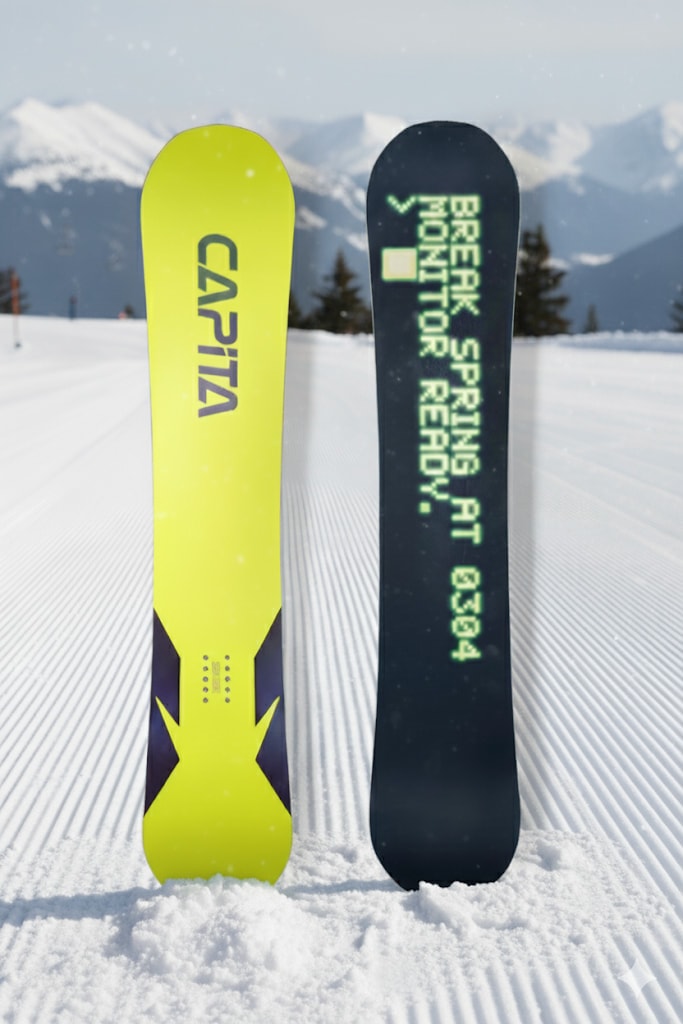
On the other hand, the Capita Spring Break Resort Twin is targeted for the rider who’s looking to hit the entire resort but doesn’t often get to ride in powder. While both boards are versatile, the Resort Twin is a little bit more flexible and balanced with being a twin, which makes it a little bit better for jibbing and landing switch. While the Mercury can jib and land switch too, it’s meant more for the rider who wants to go fast, charge hard, and hit everything in sight, but most of the time they’ll have their lead leg in front.
- Choose the Capita Mercury if you:
- Are an aggressive rider who loves to go fast and carve hard.
- Want one board that excels at high-speed charging and handling powder.
- Prioritize a powerful, stable, and damp feel over freestyle flexibility.
- Mostly ride with your lead leg forward and want to charge everything in sight.
- Choose the Capita Spring Break Resort Twin if you:
- Prefer a more playful, forgiving, and freestyle-focused ride.
- Spend a lot of time in the park, hitting jumps, rails, and side hits.
- Want a balanced board that’s great for riding and landing switch.
- Don’t ride in deep powder often but still want a versatile all-mountain board.
Bindings to Pair With the Capita Mercury
The Mercury pairs perfectly with the Union Force bindings. Both have a similar flex rating, and both are meant to be used in all types of terrain.
Review Wrap-Up: So Is the Capita Mercury Worth It?
Yes, the Capita Mercury is worth it, and there is a reason this board has been returning to the Capita lineup year after year for the last 10 years – because it rips.
If you’re looking for one board that can do it all so very well, then get the Capita Mercury.
Where to Buy the Capita Mercury
You can buy the new Capita Mercury at EVO, Tactics or Blauer Boardshop.

Image Gallery for the Review




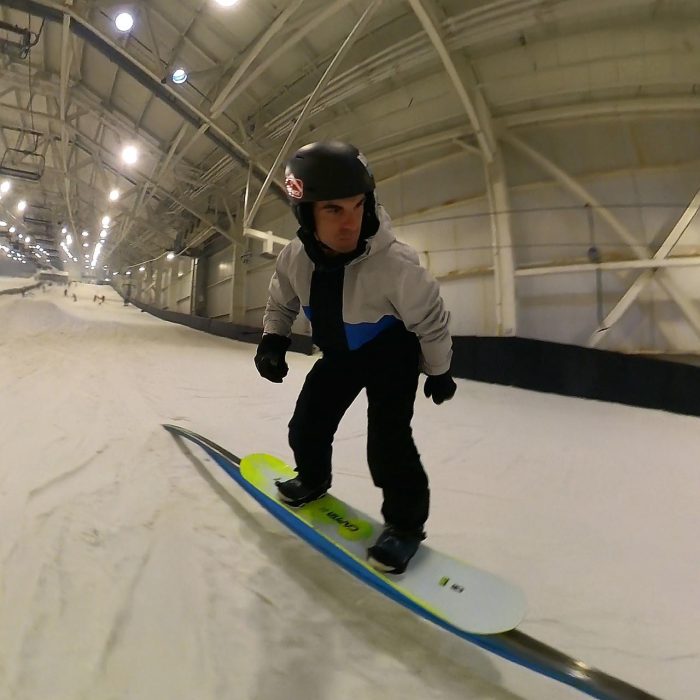
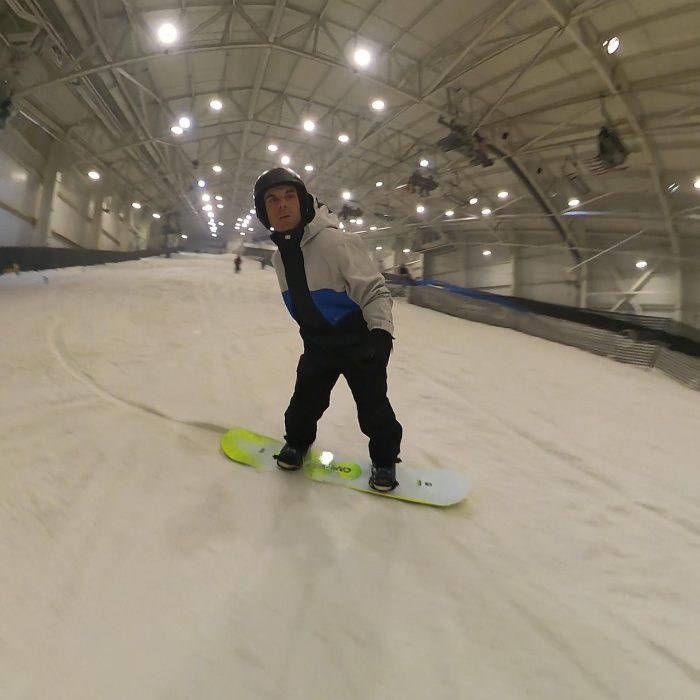

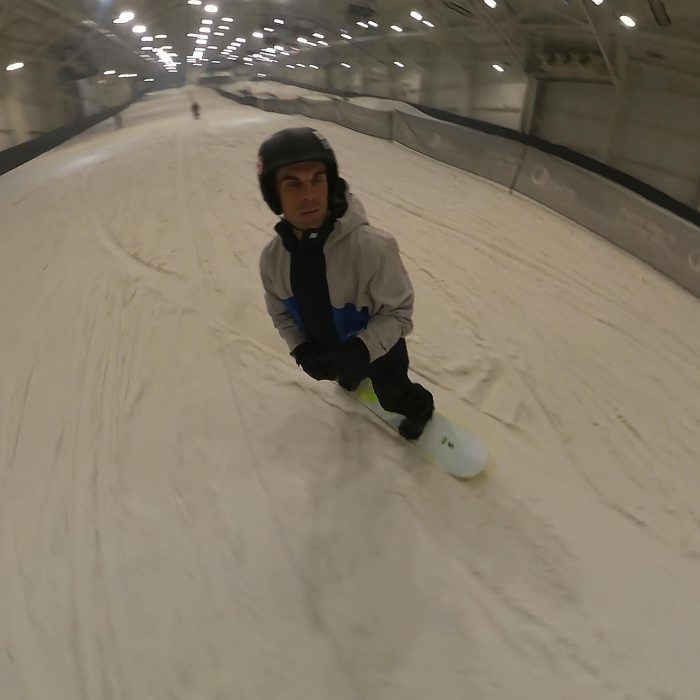
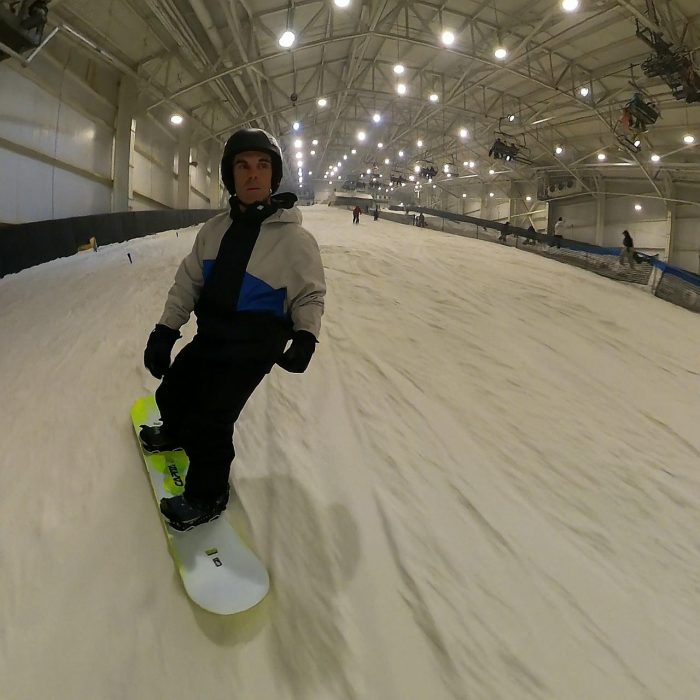
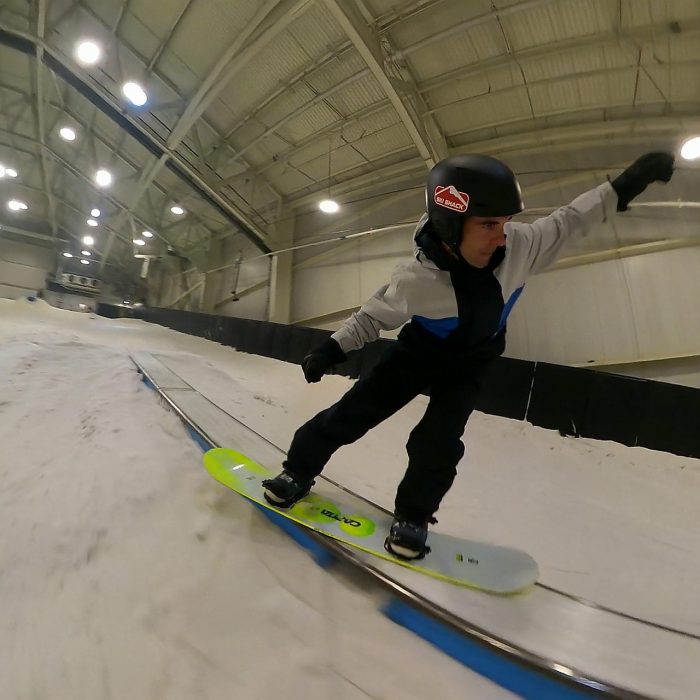
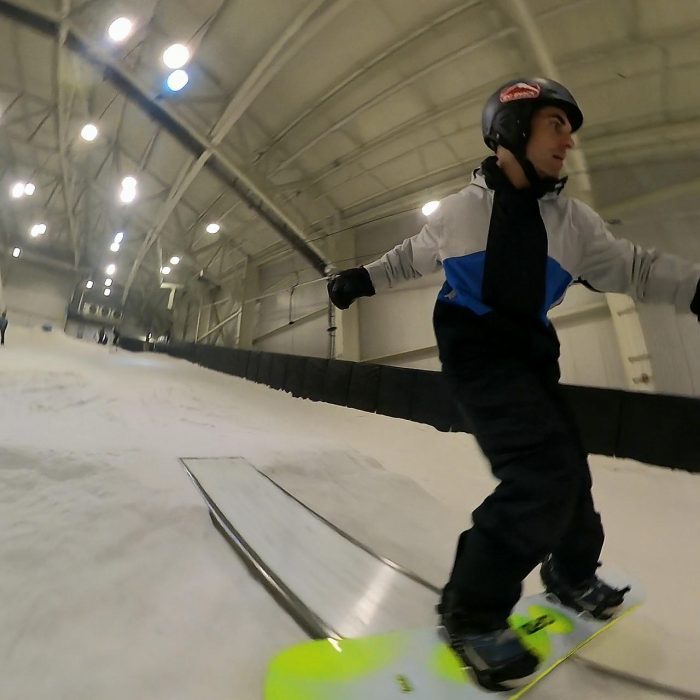


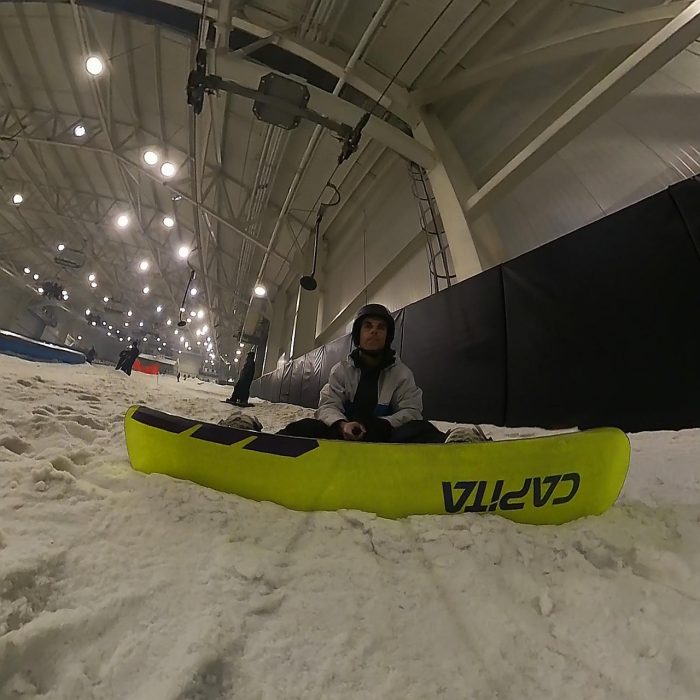




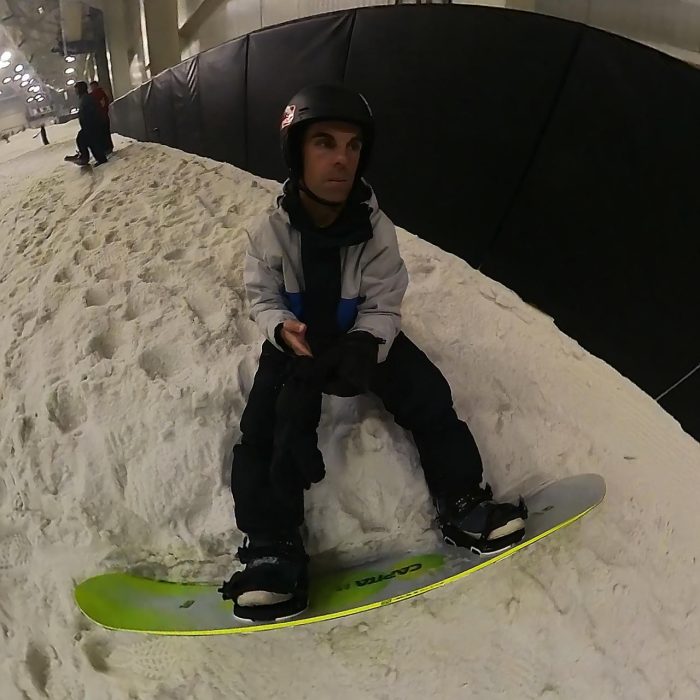



Rider Name: Steve Weber
Field Test Notes: I rode the 2026 Capita Mercury at the Capita Sync demo event on August 20th 2025 at Big Snow in East Rutherford, NJ.
Rider Experience Level: Intermediate to advanced – I’ve been riding for over 16 years. However, I lean more freestyle than freeride. I prefer hitting jumps and rails over making the perfect turn.
Rider’s Preferred Terrain: The park with small to medium sized features (so Big Snow is perfect for me).
Size / Model: The board I reviewed was a 2025 Capita Mercury in the 155cm size.
Rider Weight: 144lbs
Bindings Used: The 2026 Union Force
Steve Weber is the passionate snowboarder, skateboarder, and author behind Board of the World. He understands that most gear reviews focus on having the perfect snow conditions, but his testing methodology is different. Living in Pennsylvania, Steve describes exactly how a board performs when the conditions aren’t perfect. His reviews cover performance on ice, hardpack, and flat-out brick conditions. In other words, he reviews boards for the conditions that East Coast riders actually face.
Bringing 27 years of East Coast snowboarding and 21 years of skateboarding experience, Steve is a 42-year-old intermediate park rider. His recommendations are informed by decades of battling icy conditions, ensuring every review accounts for the board’s performance on the roughest of terrain.
For the last five years, Steve has poured his passion into writing in-depth, unbiased reviews that help riders make informed decisions about the gear they’ll use. He also works part-time at a snowboard shop in Northeastern Pennsylvania, which gives him a direct line to learning about the new gear tech months in advance. When he’s not writing reviews, Steve is often found riding at Montage Mountain and testing out new boards.
Steve’s goal with Board of the World is simple: to help every reader find the right gear so they can have fun outside from the first time they use it.

